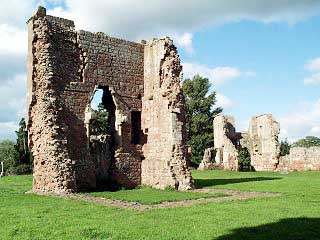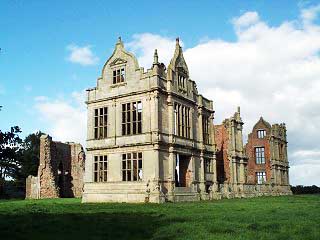Moreton Corbet
There is no sound evidence as to when Moreton Corbet castle was built, but the Domesday Book suggests that some form of residence stood here in 1086 when the English thegns Hunning and Wulfgeat held the manor. Quite possibly the remains of the early ditch around the site marks a trace of this early 'castle'. By the early twelfth century the two thegns had disappeared and the English thegn Toret had replaced them as lord of Moreton Corbet under the powerful Norman family of Verley.
 Toret (d.1108+)
and his probable son, Toret Wroxeter (d.bef.1175), were Englishmen and
it would seem possible
that they were responsible for building the rectangular tower keep, some 38' by 33', which
still
dominates the castle site. Somewhat similar
rectangular
keeps under 40' square exist in Wales at Carndochan
(35' square), Dolwyddelan
I
(25' square), Hyssington (27' square) and White Castle (35' square): and in England at Bridgnorth
(39'x35'), Clithero (35' square), Clun
(30' square), Farnham (37'
square), Goodrich
(29' square), Peak (40' square) and especially Wattlesborough
(30' square).
Toret (d.1108+)
and his probable son, Toret Wroxeter (d.bef.1175), were Englishmen and
it would seem possible
that they were responsible for building the rectangular tower keep, some 38' by 33', which
still
dominates the castle site. Somewhat similar
rectangular
keeps under 40' square exist in Wales at Carndochan
(35' square), Dolwyddelan
I
(25' square), Hyssington (27' square) and White Castle (35' square): and in England at Bridgnorth
(39'x35'), Clithero (35' square), Clun
(30' square), Farnham (37'
square), Goodrich
(29' square), Peak (40' square) and especially Wattlesborough
(30' square).
Before 1170 Peter Toret (d.1194) married Lucy Haget (d.1205+) and in her right became a powerful baron in Yorkshire. By the reign of King John his son Bartholomew Toret (d.1235) had become a member of the powerful anti-Plantagenet grouping called 'The Northerners'. In 1215 they compelled King John to sign the Magna Carta and when this failed moved a rebellion against the king. Moreton Corbet castle was one of those places which were garrisoned against John. In February 1216 Earl William Marshall of Goodrich castle, who at the time was residing at Shrewsbury, was ordered by the king to storm Moreton Corbet. This he duly did and a royalist garrison was placed within the fortress. By 1217 Bartholomew Toret and his son-in-law, Richard Corbet of Wattlesborough castle, abandoned the cause of the rebels and returned allegiance to King John's son, Henry III.

An updated version of Moreton Corbet Castle, 1066 to 1700 and the Families of Verley, Toret and Corbet (ISBN 1899376615), is now available as an A4 sized book of 110 pages. The revised book includes new photographs of the fortress and an index and can be bought for £29.95 through the PayPal basket below.